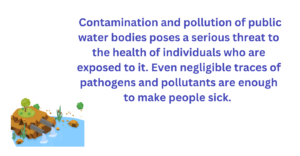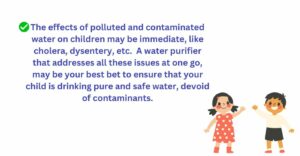The one most common thing that you as a parent might be consistently telling your kids to do, is to drink more water. Water is indeed that magic elixir that hydrates us and helps to keep our body functioning effectively. But have you given a thought about the quality of water that your child may be consuming?
According to a feature published in water.org, a child dies every two minutes due to a water-borne disease. The root cause of this shocking and horrifying fact is the gigantic problem of contaminated drinking water. Millions of children suffer from malnutrition and stunted growth, because of contaminated water and lack of sanitation.
In this blog, we investigate the causes of water contamination, and how it affects the health of children who are exposed to it.
Get 7 Days Risk Free Trial
What is water contamination?
Water contamination is one of the biggest water-related problems in India. Uncontrolled pollution levels due to the indiscriminate use of chemicals are one of the main reasons for water contamination. Untreated sewage is the singular biggest cause of water pollution in our country. This may even seep into the groundwater and pollute it too.
The presence of sewage in water translates into the rise of harmful microorganisms and pathogens such as bacteria and viruses, which may cause a slew of waterborne infections in people who come into contact with it.
Indiscriminate use of chemicals and pesticides are other major water pollutants, as they get washed into water bodies from the fields and land near them, thereby polluting them. Industrial waste from factories causes heavy pollution of water bodies as they leach traces of heavy metals and toxic substances into the water sources near them.
What happens to drinking water when it is contaminated?

Health risks
Contamination and pollution of public water bodies poses a serious threat to the health of individuals who are exposed to it. Even negligible traces of pathogens and pollutants are enough to make people sick. But this is entirely preventable. Water that you use for drinking can get contaminated either at the source from which it is procured or even during the distribution after it has been treated.
Pollutants
Pathogens, chemicals, and other pollutants can leach into water in various ways, from overflowing sewers, wildlife, and stormwater, to cracks in distributing pipelines and uncontrolled use of pesticides or chemicals, in a land near a water body.
Lead contamination
Lead is one of the most common and lethal pollutants. It makes its way to water through old pipelines, sometimes even paint or soil. In India, there are regulatory authorities to ensure that water supplied through civic sources is free from lead contamination.
Excess fluoride
Fluoride is another mineral that is harmful when used in large quantities. You may have noticed that your toothpaste contains fluoride, which is touted to be beneficial for your teeth in small quantities. It is for this reason that fluoride is added to water in its synthetic form.
Too much of this mineral manifests itself as white spots on the teeth of infants and is known as Fluorosis. Since fluoride is added to tap water it is impossible to completely avoid it, although there are regulations in place to ensure that the water supplied through civic sources contains less than the permissible level of fluorides.
Arsenic
Arsenic is a lethal contaminant, which can cause a plethora of health problems from decreased brain functioning in children, to liver and lung malignancies. It has also been associated with chronic illnesses like heart ailments, diabetes, etc. So medical practitioners all over strongly advise treating water bodies with arsenic concentrations of over 10g/L or finding another source of water for consumption.
Nitrates
Nitrates are another contaminant that causes a condition known as methemoglobinemia in infants if they are given water with a high concentration of nitrates. Nitrates are also known to cause cancer after prolonged consumption.
Bitter taste
Your drinking water can taste bitter due to the presence of iron, aluminum, or excess lime. If sodium bicarbonate is present in your water, then it may have a soapy flavor while too much salt can cause a brackish or a salty flavor to your drinking water.
Effects of contaminated water on children’s health
Children’s Immune System
Children have an immune system that is still in developmental stages and hence not as robust as adults. They also tend to consume more water per pound of their body weight, than adults. This makes them more vulnerable to the toxins present in the water that they consume. They are more at risk of getting gastrointestinal illnesses and related nausea, stomach cramps, diarrhea, etc.
Children’s Growth
The effects of contaminated drinking water on growing children whose organs and tissues are still developing, can range from minor physical ailments to severe illnesses which can also prove to be fatal in some cases.
Physical & Mental Wellness
Prolonged use of contaminated drinking water can cause a host of issues, both physical and mental in children. Cholera, dysentery, typhoid, hepatitis A, and nervous system illness are some of the diseases that can be linked to poor sanitation and unclean drinking water.
Though scientists are still working at finding concrete proof to establish the link between the presence of certain pollutants in the water and how this contaminated water affects health, it is wise to be cautious, as children’s bodies are in their critical development stages. For e.g., toxic metals like lead, mercury, etc. are known to cause brain damage in very young children and the effects are mostly irreversible.
Get 7 Days Risk Free Trial
Conclusion

The effects of polluted and contaminated water on children may be immediate, like cholera, dysentery, etc. or it may manifest over the long term, in the form of stunted brain development. A water purifier that addresses all these issues at one go, may be your best bet to ensure that your child is drinking pure and safe water, devoid of contaminants.
Advanced models of water purifiers purify even minute traces of pathogens and pollutants while enhancing the taste and odor of your output water. So, get your child to drink more of this nourishing elixir of life while ensuring your peace of mind in the process.



